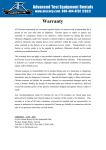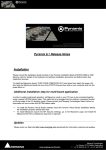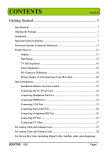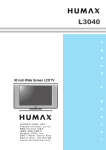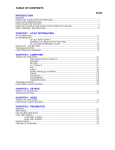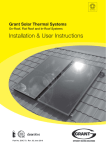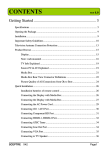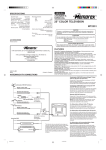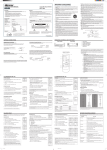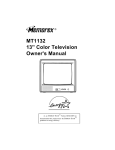Download Memorex MT3010OM Computer Monitor User Manual
Transcript
MT3010 User’s Guide 30" Wide-screen LCD Stereo HDTV* Monitor with Integrated TV Tuner * High Definition (HDTV) monitors require an optional set-top box to receive true digital high definition broadcasts. Before operating this product, please read these instructions completely. CONTENTS Contents ................................................................................................................................................................................1 Important Safety Instructions..............................................................................................................................................2 Power Source........................................................................................................................................................................4 Location of Controls ............................................................................................................................................................4 • Front...................................................................................................................................................................................4 • Rear Panel .........................................................................................................................................................................5 Remote Control.....................................................................................................................................................................6 • Battery Installation .............................................................................................................................................................7 • Effective Distance of the Remote Control Transmitter ............................................................................................................................................................7 Cable (CATV)/Satellite Connections ...................................................................................................................................8 Outdoor Antenna Connections ...........................................................................................................................................9 VCR Connections ...............................................................................................................................................................10 DVD Connections ...............................................................................................................................................................12 Stereo Connection..............................................................................................................................................................13 HDTV Connection ...............................................................................................................................................................14 Computer Connection ........................................................................................................................................................14 Wall Mounting the Unit.......................................................................................................................................................15 Clock Setting.......................................................................................................................................................................17 Setting the AIR/CABLE Option ..........................................................................................................................................18 Setting Channels into Memory..........................................................................................................................................19 Adding and Skipping Channels ........................................................................................................................................20 Setting Favorite Channels .................................................................................................................................................21 Setting the Sleep Timer......................................................................................................................................................22 TV Operation .......................................................................................................................................................................23 • Mute .................................................................................................................................................................................24 • Recall ...............................................................................................................................................................................24 • TV/AV/PC .........................................................................................................................................................................24 • MTS..................................................................................................................................................................................24 • Favorite Channel..............................................................................................................................................................24 • Sleep ................................................................................................................................................................................24 • Display .............................................................................................................................................................................25 • Video Mode ......................................................................................................................................................................25 • Audio Mode ......................................................................................................................................................................25 • Video Mute .......................................................................................................................................................................25 • Channel Lock ...................................................................................................................................................................25 • SRS..................................................................................................................................................................................25 • Wide .................................................................................................................................................................................26 • Audio AI............................................................................................................................................................................26 • PIP and POP....................................................................................................................................................................26 • Swap ................................................................................................................................................................................26 • Screen Position ................................................................................................................................................................26 • Image Source...................................................................................................................................................................26 Closed Captions .................................................................................................................................................................27 On-Screen Control Adjustments (Picture) .......................................................................................................................28 On-Screen Control Adjustments (Sound) ........................................................................................................................29 Screen Settings...................................................................................................................................................................30 Setting V-Chip .....................................................................................................................................................................32 • V-Chip Set-up...................................................................................................................................................................32 • MPAA Rating Set-up ........................................................................................................................................................33 • TV Rating Set-up .............................................................................................................................................................34 • Changing the Password...................................................................................................................................................35 Setting the On Timer ..........................................................................................................................................................36 Troubleshooting Guide ......................................................................................................................................................37 Reception Disturbances.....................................................................................................................................................38 Specifications .....................................................................................................................................................................39 Care and Maintenance .......................................................................................................................................................40 1 IMPORTANT SAFETY INSTRUCTIONS CAUTION RISK OF ELECTRIC SHOCK DO NOT OPEN CAUTION: TO REDUCE THE RISK OF ELECTRIC SHOCK, DO NOT REMOVE COVER (OR BACK). NO USER-SERVICEABLE PARTS INSIDE. REFER SERVICING TO QUALIFIED SERVICE PERSONNEL. The lightning flash with arrowhead symbol within an equilateral triangle is intended to alert the user to the presence of uninsulated dangerous voltage within the product’s enclosure that may be of sufficient magnitude to constitute a risk of electric shock to persons. The exclamation point within an equilateral triangle is intended to alert the user to the presence of important operating and maintenance (servicing) instructions in the literature accompanying the appliance. WARNING: TO REDUCE THE RISK OF FIRE OR ELECTRIC SHOCK, DO NOT EXPOSE THIS APPLIANCE TO RAIN OR MOISTURE. TO PREVENT ELECTRIC SHOCK, MATCH THE WIDE BLADE OF THE PLUG TO THE WIDE SLOT AND FULLY INSERT. Before using the unit, be sure to read all operating instructions carefully. Please note that these are general precautions and may not pertain to your unit. For example, this unit may not have the capability to be connected to an outdoor antenna. 1. READ INSTRUCTIONS All the safety and operating instructions should be read before the product is operated. 2. RETAIN INSTRUCTIONS The safety and operating instructions should be retained for future reference. 3. HEED WARNINGS All warnings on the product and in the operating instructions should be adhered to. 4. FOLLOW INSTRUCTIONS All operating and use instructions should be followed. 5. CLEANING Unplug this product from the wall outlet before cleaning. Do not use liquid cleaners or aerosol cleaners. Use a damp cloth for cleaning. 6. ATTACHMENTS Do not use attachments not recommended by the product's manufacturer as they may cause hazards. 7. WATER AND MOISTURE Do not use this product near water- for example, near a bathtub, washbowl, kitchen sink, or laundry tub, in a wet basement, or near a swimming pool. 8. ACCESSORIES Do not place this product on an unstable cart, stand, tripod, bracket, or table. The product may fall, causing serious injury and serious damage to the product. Use only with a cart, stand, tripod, bracket, or table recommended by the manufacturer or sold with the product. Any mounting of the product should follow the manufacturer’s instructions, and should use a mounting accessory recommended by the manufacturer. 8A. An appliance and cart combination should be moved with care. Quick stops, excessive force, and uneven surfaces may cause the appliance and cart combination to overturn. 9. VENTILATION Slots and openings in the cabinet and in the back or bottom are provided for ventilation and to ensure reliable operation of the product and to protect it from overheating. These openings must not be blocked or covered. The openings should never be blocked by placing the product on a bed, sofa, rug, or other similar surface. This product should never be placed near or over a radiator or heat source. This product should not be placed in a built-in installation such as a bookcase or rack unless proper ventilation is provided or the manufacturer's instructions have been adhered to. 10. POWER SOURCES This product should be operated only from the type of power source indicated on the marking label. If you are not sure of the type of power supply to your home, consult your appliance dealer or local power company. For products intended to operate from battery power, or other sources, refer to the operating instructions. 11. GROUNDING OR POLARIZATION This product is equipped with a polarized alternating-current line plug (a plug having one blade wider than the other). This plug will fit into the power outlet only one way. This is a safety feature. If you are unable to insert the plug fully into the outlet, try reversing the plug. If the plug should still fail to fit, contact your electrician to replace your obsolete outlet. Do not defeat the safety purpose of the polarized plug. 12. POWER-CORD PROTECTION Power-supply cords should be routed so that they are not likely to be walked on or pinched by items placed upon or against them, paying particular attention to cords at plugs, convenience receptacles, and the point where they exit from the appliance. PORTABLE CART WARNING (symbol provided by RETAC) S3126A 2 IMPORTANT SAFETY INSTRUCTIONS (CONTINUED) 13. LIGHTNING To protect your product from a lightning storm, or when it is left unattended and unused for long periods of time, unplug it from the wall outlet and disconnect the antenna or cable system. This will prevent damage to the product due to lightning and power-line surges. 14. POWER LINES An outside antenna system should not be located in the vicinity of overhead power lines or other electric light or power circuits, or where it can fall into such power lines or circuits. When installing an outside antenna system, extreme care should be taken to keep from touching such power lines or circuits as contact with them might be fatal. 15. OVERLOADING Do not overload wall outlets and extension cords as this can result in a risk of fire or electric shock. 16. OBJECT AND LIQUID ENTRY Never push objects of any kind into this product through openings as they may touch dangerous voltage points or short out parts that could result in fire or electric shock. Never spill or spray any type of liquid on the product. 17. OUTDOOR ANTENNA GROUNDING If an outside antenna is connected to the product, be sure the antenna system is grounded so as to provide some protection against voltage surges and built-up static charges. Section 810 of the National Electric Code, ANSI/NFPA 70, provides information with respect to proper grounding of the mast and supporting structure, grounding of the lead-in wire to an antenna discharge product, size of grounding conductors, location of antenna discharge product, connection to grounding electrodes, and requirements for grounding electrode. 18. SERVICING Do not attempt to service this product yourself as opening or removing covers may expose you to dangerous voltage or other hazards. Refer all servicing to qualified service personnel. 19. REPLACEMENT PARTS When replacement parts are required, be sure the service technician uses replacement parts specified by the manufacturer or those that have the same characteristics as the original part. Unauthorized substitutions may result in fire, electric shock or other hazards. 20. SAFETY CHECK Upon completion of any service or repairs to this product, ask the service technician to perform safety checks to determine that the product is in proper operating condition. 21. WALL OR CEILING MOUNTING The product should be mounted to a wall or ceiling only as recommended by the manufacturer. 22. DAMAGE REQUIRING SERVICE Unplug the product from the wall outlet and refer servicing to qualified service personnel under the following conditions: a. When the power-supply cord or plug is damaged. b. If liquid has been spilled, or objects have fallen into the product. c. If the product has been exposed to rain or water. d. If the product does not operate normally by following the operating instructions. Adjust only those controls that are covered by the operating instructions, as an adjustment of other controls may result in damage and will often require extensive work by a qualified technician to restore the product to its normal operation. e. If the product has been dropped or the cabinet has been damaged. f. When the product exhibits a distinct change in performance - this indicates a need for service. 23. HEAT The product should be situated away from heat sources such as radiators, heat registers, stoves, or other products (including amplifiers) that produce heat. 24. NOTE TO CATV SYSTEM INSTALLER This reminder is provided to call the CATV system installer's attention to Article 820-40 of the NEC that provides guidelines for proper grounding and, in particular, specifies that the cable ground shall be connected to the grounding system of the building, as close to the point of cable entry as practical. ANTENNA LEAD IN WIRE GROUND CLAMP ANTENNA DISCHARGE UNIT (NEC SECTION 810-20) ELECTRIC SERVICE EQUIPMENT GROUNDING CONDUCTORS (NEC SECTION 810-21) GROUND CLAMPS POWER SERVICE GROUNDING ELECTRODE SYSTEM NEC - NATIONAL ELECTRICAL CODE S2898A 3 (NEC ART 250, PART H) EXAMPLE OF ANTENNA GROUNDING AS PER NATIONAL ELECTRICAL CODE POWER SOURCE To operate the unit using AC power, connect the AC Adapter to the AC jack on the rear of the unit, then connect the AC adapter to a wall outlet having 120V AC, 60Hz only. NOTE: If the AC adapter’s plug does not fit into a nonpolarized outlet, do not file or cut the wide blade. CAUTION: Use only the AC adapter provided with this unit. Using another AC AC Plug adapter may damage the unit. When not using AC power, disconnect the AC adapter from the wall outlet by pulling the plug (not the cord). Do not touch the AC adapter with wet hands. LOCATION OF CONTROLS FRONT 1 8 1. 2. 3. 4. 5. 6. AC Outlet 2 3 4 5 6 7 9 10 POWER Button - Press to turn the TV on; the POWER indicator will light green and picture will appear in approximately five seconds. Press again to turn the TV off; the Power indicator will light red. 7. 8. 9. CHANNEL Down Button - Press to select a lower numbered channel. 13 14 TV/VIDEO/PC Button - Press to switch between the TV and the video inputs. Left Speaker Screen 10. Base Stand 11. REMOTE SENSOR CHANNEL Up Button - Press to select a higher numbered channel. 12. POWER Indicator - Lights green when the unit is warming up or is on, and lights red when the unit is off. VOLUME Down Button - Press to lower the volume. 13. AC Jack (Rear of Unit) VOLUME Up Button - Press to raise the volume. MENU Button - Press to access the On-Screen menu. 11 12 14. Right Speaker 4 LOCATION OF CONTROLS (CONTINUED) REAR PANEL 5 1 6 2 7 3 8 4 1. HDTV IN Jacks (R/L/PR/PB/Y) 2. S IN Jacks (R/L/S) 3. AV IN Jacks (R/L/V) 4. VGA IN Jack 5. UHF/VHF Antenna Jack 6. AUDIO OUT Jacks (R/L) 7. VGA AUDIO IN Jacks (R/L) 8. COMPONENT IN Jacks (R/L/CR/CB/Y) 5 REMOTE CONTROL 16 17 18 19 1 2 3 4 20 5 21 6 7 8 9 10 11 12 13 14 15 1. RECALL Button 2. CH LOCK Button 3. TV/AV/PC Button 4. CHANNEL Up Button 5. VOLUME Down Button 6. CHANNEL Down Button 7. MTS Button 8. VIDEO MODE Button 9. WIDE Button 10. AUDIO MODE Button 11. SRS (Surround Sound) Button 12. IMAGE SOURCE Button 13. PIP/POP Button 14. SET Button 15. V-CHIP Button 22 23 24 25 26 27 28 29 16. POWER Button 17. Direct Channel Selection Buttons 18. FAVORITE CHANNEL Up Button 19. FAVORITE CHANNEL Down Button 20. MENU Button 21. VOLUME Up Button 22. MUTE Button 23. DISPLAY Button 24. VIDEO MUTE Button 25. SLEEP TIMER Button 26. AUDIO AI Button 27. SWAP Button 28. SCREEN POSITION Button 29. CCD (Closed Caption Display) Button 6 BATTERY INSTALLATION REMOTE CONTROL (CONTINUED) 1 – Open the battery compartment cover. Install two “AAA” batteries, paying attention to the polarity diagram in the battery compartment. +– Replace the battery compartment cover. + BATTERY PRECAUTIONS Follow these precautions when using batteries in this device: 1. Use only the size and type of batteries specified. 2. Be sure to follow the correct polarity when installing the batteries as indicated in the battery compartment. Reversed batteries may cause damage to the device. 3. Do not mix different types of batteries together (e.g. Alkaline, Rechargeable and Carbon-zinc) or old batteries with fresh ones. 4. If the device is not to be used for a long period of time, remove the batteries to prevent damage or injury from possible battery leakage. 5. Do not try to recharge batteries not intended to be recharged; they can overheat and rupture. (Follow battery manufacturer’s directions.) EFFECTIVE DISTANCE OF THE REMOTE CONTROL TRANSMITTER NOTES: 15 ft • When there is an obstacle between the TV and the transmitter, the transmitter may not operate. 30° • When direct sunlight, incandescent lamp, fluorescent lamp or any other strong light shines on the REMOTE SENSOR of the TV, the remote operation may be unstable. 30° FAQs: Why is the remote control not working properly? • The remote control is not aimed at the sensor. • The remote control is too far away from the remote sensor. • There is too much light in the room. • There is an obstacle in the path of the beam. • The batteries are weak or dead. • The batteries are inserted incorrectly. • The TV is not plugged in. • The proper Function button is not pressed. For example, press the TV button to use the remote to operate the TV. 7 CABLE (CATV)/SATELLITE CONNECTIONS This TV has an extended tuning range and can tune most cable channels without using a Cable TV converter box. Some Cable TV companies offer “premium pay channels” in which the signal is scrambled. Descrambling these signals for normal viewing requires the use of a descrambler device which is generally provided by the cable company. FOR SUBSCRIBERS TO BASIC CABLE TV SERVICE For basic cable tv service not requiring a converter/descrambler box, connect the CATV 75 ohm coaxial cable to the VHF/UHF jack on the rear of the TV. FOR SUBSCRIBERS TO SCRAMBLED CABLE TV SERVICE OR SATELLITE If you subscribe to a satellite service or a cable TV service which requires the use of a converter/descrambler box, connect the incoming 75 ohm coaxial cable to the converter/descrambler or satellite box. Using another 75 ohm cable, connect the output of the converter/descrambler or satellite box to the antenna jack on the TV. Follow the connections shown below. Set the TV/VCR to the output channel of the converter/descrambler or satellite box (usually 3 or 4) and use the converter/descrambler or satellite box to select channels. CONVERTER/ INCOMING 75 OHM DESCRAMBLER OR SATELLITE BOX 75 OHM CABLE TO TV/VCR CATV CABLE FOR SUBSCRIBERS TO UNSCRAMBLED BASIC CABLE TV SERVICE WITH SCRAMBLED PREMIUM CHANNELS If you subscribe to a satellite service or a cable TV service in which basic channels are unscrambled and premium channels require the use of a converter/descrambler box, you may wish to use a signal splitter and an A/B switch box (available from the cable company or an electronic supply store). Follow the connections shown below. With the switch in the “B” position, you can directly tune any nonscrambled channels on your TV. With the switch in the “A” position, tune your TV to the output of the converter/descrambler box (usually channel 3 or 4) and use the converter/descrambler box to tune scrambled channels. CONVERTER/ INCOMING SPLITTER DESCRAMBLER A/B SWITCH 75 OHM 75 OHM CABLE CATV CABLE FAQS: I connected my cable, why can’t I get channels above 69? Make sure AIR/CABLE is set to CABLE, see page 17. Also, make sure your cable company broadcasts channels in the range you are searching. Are the cables included? No, the cables are sold separately; visit your local electronics store. 8 OUTDOOR ANTENNA CONNECTIONS OUTDOOR VHF/UHF ANTENNA CONNECTION (ANTENNA NOT SUPPLIED) Follow the instructions for the type of antenna system you intend to use. Combination VHF/UHF Antenna (Single 75 ohm cable or 300 ohm twin-lead wire) Combination VHF/UHF Antenna (Separate VHF and UHF 300 ohm twin-leads) Separate VHF/UHF Antennas UHF 300 Ohm UHF 300 Ohm VHF/UHF Combiner 75 Ohm Connect the 75 ohm cable from the combination VHF/UHF antenna to the antenna jack. OR If your combination antenna has a 300 ohm twin-lead wire, use a 300-75 ohm matching transformer (NOT SUPPLIED). VHF 300 Ohm Connect the UHF twin-lead wire to a combiner (NOT SUPPLIED). Connect the VHF twin-lead to a 300-75 ohm matching transformer (NOT SUPPLIED). Attach the transformer to the combiner. Attach the combiner to the antenna jack. 9 Combiner VHF 75 Ohm Connect the 75 ohm cable from the VHF antenna and the UHF antenna twin-lead wire to a combiner (NOT SUPPLIED). Attach the combiner to the antenna jack. NOTE: If your VHF antenna has a twinlead wire use a 300-75 ohm matching transformer, then connect the transformer to the combiner. VCR CONNECTIONS CONNECTION USING COAXIAL CABLE: Follow the instructions below to connect a VCR to your television using a 75 ohm coaxial cable. (CABLES NOT INCLUDED.) VCR REAR OF TV INCOMING CATV CABLE From VCR OUT jack 1. Connect the cable, satellite or incoming antenna to the VHF/UHF IN jack on the rear of the VCR. 2. Connect a 75 ohm coaxial cable from the VCR’s 75 Ohm OUT jack to the ANT jack on the rear of the TV. 3. Press the TV/VIDEO/PC button until regular TV or CATV appears on the TV screen and press PLAY on the VCR to watch a tape. CONNECTION USING AUDIO/VIDEO CABLES: Follow the instructions below to connect a VCR to your television using Audio/Video cables. (CABLES NOT INCLUDED.) REAR OF TV VCR INCOMING CATV CABLE From VCR OUT jacks AUDIO/VIDEO Cord To TV IN jacks 1. Connect the cable, satellite or incoming antenna to the VHF/UHF IN jack on the rear of the VCR. 2. Connect the left and right audio cable from the VCR’s Audio OUT jacks to the TV’s audio left and right AV IN jacks. Connect the VCR’s video OUT jack to the TV’s video AV IN jack. 3. Press the TV/VIDEO/PC button until AV appears on the TV screen and press PLAY on the VCR to watch a tape. FAQ: My VCR has only 1 Audio jack, but this TV has two Audio input jacks, how do I connect it? Simply connect it to the “L (Mono)” Audio input jack, but the sound will be monaural. 10 VCR CONNECTIONS (CONTINUED) CONNECTION USING S-VIDEO CABLE: Follow the instructions below to connect an S-VIDEO VCR to your television using an S-video cable. (CABLES NOT INCLUDED.) REAR OF TV OF TV REAR VCR To S AUDIO IN jacks INCOMING CATV CABLE To S VIDEO IN jack From VCR AUDIO OUT jacks AUDIO Cord 1. Connect the cable, satellite or incoming antenna to the ANT jack on the rear of the VCR. 2. Connect the left and right audio cable from the VCR’s Audio OUT jacks to the TV’s audio left and right S IN jacks. 3. Connect the VCR’s S-VIDEO OUT jack to the TV’s S-VIDEO IN jack. 4. Press the TV/VIDEO/PC button until S VIDEO appears on the TV screen and press PLAY on the VCR to watch a tape. 11 DVD CONNECTIONS CONNECTION USING AUDIO/VIDEO CABLES: Follow the instructions below to connect a DVD player to your television using Audio/Video cables. (CABLES NOT INCLUDED.) REAR OF TV DVD PLAYER From DVD OUT AUDIO/VIDEO jacks AUDIO/VIDEO Cord To TV IN jacks 1. Connect the left and right audio cable from the DVD’s Audio OUT jacks to the TV’s audio left and right AV IN jacks. Connect the DVD’s video OUT jack to the TV’s video AV IN jack. 2. Press the TV/VIDEO/PC button until AV appears on the TV screen and press PLAY on the DVD to watch a DVD. CONNECTION USING S-VIDEO CABLE: Follow the instructions below to connect a DVD player to your television using the S-Video cable. (CABLES NOT INCLUDED.) REAR OF TV OF TV REAR DVD PLAYER To S AUDIO IN jacks To S VIDEO IN jack From DVD AUDIO OUT jacks AUDIO Cord 1. Connect the left and right audio cable from the DVD’s Audio OUT jacks to the TV’s audio left and right S IN jacks. 2. Connect the DVD’s S-VIDEO OUT jack to the TV’s S-VIDEO IN jack. 3. Press the TV/VIDEO/PC button until S-VIDEO appears on the TV screen and press PLAY on the DVD to watch the DVD. 12 DVD CONNECTIONS (CONTINUED) CONNECTION USING COMPONENT CABLES: Follow the instructions below to connect a DVD player to your television using the Cr, Cb, Y jacks. (CABLES NOT DVD PLAYER From AUDIO OUT Jacks To AUDIO IN Jacks From COMPONENT VIDEO OUT Jacks To COMPONENT IN jacks NOTE: Connecting the DVD player to the TV using the component cables will provide the highest quality picture. Connecting using an S-video cable will provide the next highest quality picture, followed by standard Audio/Video cable connection. 1. Connect the left and right audio cable from the DVD’s Audio OUT jacks to the TV’s audio left and right AV IN jacks. 2. Connect a video cable from the DVD’s Y, Pb, Pr OUT jacks to the TVs AV2 DVD IN (Cr, Cb, Y) jacks. 3. Press the TV/VIDEO/PC button until COMPONENT appears on the TV screen and press PLAY on the DVD to watch a DVD. STEREO CONNECTION Follow the instructions below to connect a stereo system to your television. (CABLES NOT INCLUDED.) STEREO REAR OF UNIT To Stereo's AUDIO IN jacks From AUDIO OUT jacks AUDIO/VIDEO Cord 1. Connect the left and right audio cable from the TV’s left and right Audio OUT jacks to the stereo system’s left and right Audio IN jacks. 2. Refer to the stereo system’s owner’s manual for instructions. 13 HDTV CONNECTION Follow the instructions below to connect an HDTV set top box to your television. (CABLES NOT INCLUDED.) AUDIO/VIDEO Cord From HDTV AUDIO OUT jacks HDTV SET TOP BOX To TV AUDIO IN jacks REAR OF TV From HDTV OUT jacks Video Cord To TV PR, PB,Y IN jacks 1. Connect the left and right audio cable from the HDTV’s Audio OUT jacks to the TV’s HDTV left and right Audio IN jacks. 2. Connect a video cable from the Y, Pb, Pr OUT jacks to the TV’s HDTV IN jacks. 3. Press the TV/VIDEO/PC button until Y Pb Pr appears on the TV screen. COMPUTER CONNECTION Follow the instructions below to connect a computer to your television/monitor. (CABLES NOT INCLUDED.) COMPUTER REAR OF TV From AUDIO OUT jacks From VGA OUT jack To AUDIO IN Jacks When connected to a computer and the unit is in the PC mode, you can then adjust the following after pressing the MENU button: H position: Horizontal (left and right) position on the screen. V position: Vertical (up and down) position on the screen. Phase: Adjust the phase to get the best picture. To VGA IN jack 1. Connect the left and right audio cable from the computer’s Audio OUT jacks to the TV’s left and right VGA AUDIO IN jacks. 2. Connect a VGA cable from the computer’s VGA OUT jack to the TV’s VGA IN jack. 3. Press the TV/VIDEO/PC button until PC appears on the TV screen. 4. Refer to the computer’s owner’s manual for instructions. 14 WALL MOUNTING THE UNIT Please follow the instructions and figure below to install the unit using the supplied wall brackets and Hook Assemblies: 1. Before wall mounting the unit, you must remove the base stand as follows: a. Remove the two screws, then remove the base cover as shown in figure 1. b. Remove the eight screws, then remove the base stand as shown in figure 2. FIGURE 1 FIGURE 2 CONTINUED ON THE NEXT PAGE 15 WALL MOUNTING THE UNIT (CONTINUED) 2. Drill four 5mm holes through the wall for each bracket, or if there is a stud behind the wall where you are putting the bracket, drill four 5mm holes through the wall and into the studs for each bracket. See below figure 3 for lengths. FIGURE 3 3. Secure the Hook Assemblies (A) to the TV by inserting the two screws for each Hook Assembly in the pre-drilled holes in the rear of the set as shown in figure 4. 4. With a helper’s assistance, place the Hook Assemblies (A) carefully onto the Brackets (B) and slide down until it is secure. CAUTION: You must make sure the brackets are very securely screwed into the wall and the Hook Assemblies are securely attached to the TV before securing the TV to the wall. B A A A BB FIGURE 4 16 CLOCK SETTING 1 2 1 1 2 2 3 Press the POWER button ❶ to turn on the TV; the POWER indicator will light green. Press the MENU button ❷; the MENU screen will appear. Press the CHANNEL UP ❶ or DOWN ❷ button until SYSTEM SETTING is selected, then press the VOLUME UP button ❸ to select it. Press the CHANNEL UP ❶ or DOWN ❷ button until CURRENT TIME is selected. 3 4 1 2 Set the hours using the VOLUME DOWN button ❶ and set the minutes using the VOLUME UP button ❷. Press the MENU button once when finished to return to the Main menu. Press the MENU button again to exit the Main menu. If no button pressed for 15 seconds, the menu will disappear automatically. 17 SETTING THE AIR/CABLE OPTION Set the AIR/CABLE option as follows: 1 2 1 1 2 2 3 Press the POWER button ❶ to turn on the TV; the POWER indicator will light green. Press the MENU button ❷; the MENU screen will appear. Press the CHANNEL UP ❶ or DOWN ❷ button until SYSTEM SETTING is selected, then press the VOLUME UP button ❸ to select it. Press the CHANNEL UP ❶ or DOWN ❷ button until AIR/CABLE is selected. 3 4 2 1 Press the MENU button once when finished to return to the Main menu. Press the MENU button again to exit the Main menu. If no button pressed for 15 seconds, the menu will disappear automatically. Press the VOLUME UP ❶ or DOWN ❷ button to select between AIR and CABLE. 18 SETTING THE CHANNELS INTO MEMORY This TV is equipped with a channel memory feature which allows channels to skip up or down to the next channels set into memory, skipping over unwanted channels. Before selecting channels, they must be programmed into the TV’s memory. In addition to normal VHF/UHF channels, this TV can receive up to 113 Cable TV channels. 1 2 1 1 2 2 3 Press the POWER button ❶ to turn on the TV; the POWER indicator will light green. Press the MENU button ❷; the MENU screen will appear Press the CHANNEL UP ❶ or DOWN ❷ button until CHANNEL SETTING is selected, then press the VOLUME UP button ❸ to select it. Press the CHANNEL UP ❶ or DOWN ❷ button until AUTO SCAN is selected. 3 4 2 1 Press the VOLUME UP ❶ or DOWN ❷ button to stop Auto Memory while it is searching (if desired). When AUTO MEMORY is selected, press the VOLUME UP button to start the Auto Search. The TV will automatically cycle through all the channels and store active channels into memory. When completed, the TV will be on the first available channel. FAQs: Why can’t I access TUNING? You cannot access the TUNING option if you are not in the AIR/CABLE mode, there is no need to. How many channels will I actually receive? The actual number of channels that can be received depends on how many channels your cable or satellite company, or local area provides. Contact your company to determine the number of channels in your area. Do channels need to be set into memory before using the CHANNEL UP or DOWN button? Yes, the channels must be programmed into memory. 19 ADDING AND SKIPPING CHANNELS After setting channels into memory, you can add or delete channels as follows: 1 2 1 1 2 2 3 Press the POWER button ❶ to turn on the TV; the POWER indicator will light green. Press the MENU button ❷; the MENU screen will appear Press the CHANNEL UP ❶ or DOWN ❷ button until CHANNEL SETTING is selected, then press the VOLUME UP button ❸ to select it. Press the CHANNEL UP ❶ or DOWN ❷ button until CH SELECT is selected. 3 4 2 1 1 2 Select a channel to be skipped or added using the VOLUME UP ❶ or DOWN ❷ button. Press the CHANNEL UP ❶ or DOWN ❷ button until CHANNEL SKIPPED is selected. 5 6 2 1 Using the VOLUME UP ❶ or DOWN ❷ button, select YES to skip the channel or NO to keep the channel. Press the MENU button once when finished to return to the Main menu. Press the MENU button again to exit the Main menu. If no button pressed for 15 seconds, the menu will disappear automatically. 20 SETTING FAVORITE CHANNELS Set up to ten channels into the Favorite Channel Preferences to easily access the channel. Set as follows: 1 2 1 1 2 2 3 Press the POWER button ❶ to turn on the TV; the POWER indicator will light green. Press the MENU button ❷; the MENU screen will appear Press the CHANNEL UP ❶ or DOWN ❷ button until CHANNEL SETTING is selected, then press the VOLUME UP button ❸ to select it. Press the CHANNEL UP ❶ or DOWN ❷ button until CH SELECT is selected 3 4 2 1 1 2 Select a channel to be added to the Favorite Channel Preferences using the VOLUME UP ❶ or DOWN ❷ button. Press the CHANNEL UP ❶ or DOWN ❷ button until PREFERENCES is selected. 5 6 2 3 2 1 1 Using the VOLUME UP ❶ or DOWN ❷ button, select YES to add the channel to the preferences or NO to delete or not add the channel to the preferences. You can set up to 10 Favorite Channels. Exit the menu by pressing the MENU button ❸ twice. When watching TV, simply press the FAVORITE CHANNEL UP ❶ or DOWN ❷ button to cycle through your favorite channels. 21 SETTING THE SLEEP TIMER To set the TV to turn off after a preset amount of time, follow the steps below: 1 2 1 1 2 2 3 Press the POWER button ❶ to turn on the TV; the POWER indicator will light green. Press the MENU button ❷; the MENU screen will appear Press the CHANNEL UP ❶ or DOWN ❷ button until SYSTEM SETTING is selected, then press the VOLUME UP button ❸ to select it. Press the CHANNEL UP ❶ or DOWN ❷ button until SLEEP TIMER is selected. 3 4 2 1 Press the MENU button once when finished to return to the Main menu. Press the MENU button again to exit the Main menu. If no button pressed for 15 seconds, the menu will disappear automatically. The TV will then stay on for the selected time, and then shut off automatically. Select the desired sleep time from 10 minutes (“10M”) to 90 minutes (“90M”) using the VOLUME UP ❶ button. NOTE: To cancel the sleep function, press the VOLUME DOWN button ❷ to select OFF or use the VOLUME UP button ❶ to select “00M”. 22 TV OPERATION 1 2 OPTIONS If using a VHF/UHF antenna. AIR: CABLE: If using Cable TV. Press the POWER button to turn on the TV; the POWER indicator will light green. Set the AIR/CABLE option as described on page 18. 3 4 3 2 1 1 2 Adjust the volume level by pressing the VOLUME UP ❶ or DOWN ❷ button. The volume level will be indicated on the screen by a green numerical display between 0 and 100 where 0 is the lowest setting and 100 is the loudest. For proper operation, before selecting channels, they must be set into the TV’s program memory, see page 19. Press and release the CHANNEL UP ❶ or DOWN ❷ button. The TV automatically stops at the next channel set into memory. This will not operate if channels are not set into memory. Direct Program Selection buttons (0 - 9, 100+) Use these buttons to select a channel. The channel number will appear at the top right corner of the screen. • For Channels 01 through 99, press the two digits in order. • For Channels 100 through 125, press the 100 button ❸, then the remaining two digits. NOTES: • When TV/CATV is set to TV, only channels up to 69 can be selected. When set to CATV, channels up to 125 can be selected. • If an invalid channel is selected, the display will revert to the original channel. FAQs: Why do I only receive 69 channels, when my cable goes much higher? AIR/CABLE option must be set to CABLE when using cable, see page 18. Why are some channels scrambled? You must subscribe to these channels through your cable company. 23 TV OPERATION (CONTINUED) MUTE RECALL 1 1 3 2 1 Press the MUTE button ❶ to turn off the sound. The TV’s sound will be silenced and “AUDIO MUTE” will appear on the screen for a few seconds. The sound can be turned back on by pressing this button again or one of the VOLUME UP ❷ or DOWN ❸ button. Press the RECALL button to go back to the last channel selected. Press the RECALL button again to return to the channel you were watching. TV/AV/PC MTS Repeatedly press this button to cycle through the device(s) connected to the INPUT jacks (TV/CATV, AV, S-VIDEO, COMPONENT, YPbPr and PC). Press to select one of the following sound modes: STEREO: Select for channels that are broadcasting in stereo. MONO: Select for channels broadcasting in mono or if you are having difficulty receiving a stereo signal. SAP (Separate Audio Program): Select to listen to a Separate Audio Program which is usually a foreign language translation. FAVORITE CHANNEL SLEEP TIMER 1 1 1 1 2 1 Press the FAVORITE CHANNEL UP ❶ or DOWN ❷ button to cycle through your favorite channels, as set on page 21. 24 Press repeatedly to set the sleep time between “00” and “90” (each press will increase the time by 10 minutes). When the sleep time is up, the TV will shut off. Select “00” to cancel the sleep function. DISPLAY TV OPERATION (CONTINUED) VIDEO MODE 1 1 Press the DISPLAY button once to show the time. Press again to show the mode (i.e. S-VIDEO). Press a third time to clear the screen or wait three seconds and the screen will clear automatically. Press to select a mode (PRESET, SOFT or USER) as set on page 28. NOTE: You cannot change the video MODE while using the Y Pb Pr or computer inputs. AUDIO MODE VIDEO MUTE Press to select a mode (PRESET, SOFT or USER) as set on page 29. NOTE: You cannot change the audio MODE while using the Y Pb Pr or computer inputs.. Press and the picture will disappear from the screen, but the sound will still be heard. CHANNEL LOCK SRS Channel Lock provides instant access to one of your favorite channels at the touch of a button. To set, go to the channel you want to set as the channel lock, then press and hold the CHANNEL LOCK button on the remote until the on-screen display shows “LOCKED”; the channel is now locked in. To access, simply press the CHANNEL LOCK button on the remote and the TV will automatically tune to that channel. This feature allows the TV’s left and right speakers to provide a surround sound effect. Press to cycle through the surround modes as follows: SURROUND 1: Simulated stereo SURROUND 2: Stereo surround SURROUND 3: Mono surround SURROUND OFF: To turn off surround sound. 1 1 1 1 25 WIDE TV OPERATION (CONTINUED) AUDIO AI 1 1 Press the WIDE button to select one of the screen modes: FULL: The image will stretch to cover the full screen; use this MODE when viewing wide-screen programming material. M1: The image will increase slightly over the standard size M2: The image will increase slightly over M1. M3: The image will increase slightly over M2. M4: The image will increase slightly over M3. 4:3: The image will be the standard viewing size. Each broadcasting channel has its own signal conditions and it is inconvenient to adjust the volume every time the channel is changed or when a commercial comes on. Audio AI automatically adjusts the volume of the desired channel by lowering the sound output when the modulation signal is high or by raising the sound output when the modulation signal is low. Press the AUDIO AI button to turn this feature on or off. PIP and POP SWAP 1 1 Press the PIP/POP button to turn picture-in-picture on; press a second time to turn picture on picture (split screen) on (this will show a picture next to a picture). Press a third time to turn PIP or POP off. NOTE: One picture will be used for the TV/AV/S-VIDEO/ COMPONENT signal and the other picture will be used for the HDTV-YPbPr/PC signal only. Press the SWAP button to alternate the screens when using PIP or POP. This will also alternate what screen the VOLUME, VIDEO SOURCE, etc buttons control. SCREEN POSITION IMAGE SOURCE Press this button to select one of the four corners of the screen for the PIP picture. When PIP or POP selection is on, press the IMAGE SOURCE button to change the mode of the picture (the picture with the green color boundary). NOTE: If in the PC or YPbPr mode, you can only change to PC or YPbPr mode. If in the TV, AV, S-VIDEO or COMPONENT mode, you can only change to the TV, AV, S-VIDEO or COMPONENT mode. For example, you cannot change from PC mode to S-VIDEO mode. 1 1 26 WHAT IS CLOSED CAPTIONING? CLOSED CAPTIONS TEXT: The Text Closed Caption Mode will usually fill the screen with a programming schedule or other information. OFF: Turns closed captions off. CHANNEL: Select between the four closed caption channels. After selecting a Closed Caption Mode, it will stay in effect until it is changed, even if the channel is changed. If the Captions signal is lost due to a commercial or a break in the signal, the Captions will reappear when the signal is received again. If the channels are changed, the Captions will be delayed approximately 10 seconds. The Captions will appear in places on the screen where they will least interfere with the picture, usually on the bottom of the screen. News programs will usually show three-line Closed Captions which scroll onto the screen. Most other shows provide two or three lined Captions placed near the character who is speaking so the viewer can follow the dialogue. Words in italics or underlined describe titles, words in foreign languages or words requiring emphasis. Words that are sung usually appear enclosed by musical notes. For television programs broadcasting with Closed Captions, look in your TV guide for the Closed Captions symbol (CC). This television has the capability to decode and display Closed Captioned television programs. Closed Captioning will display text on the screen for hearing impaired viewers or it will translate and display text in another language. CLOSED CAPTIONING WITH A VCR Closed Captioned programs can be recorded and played back on a VCR with the Closed Captioned text intact. The Closed Captioned text will disappear during Cue (Fast Forward Search), Review (Rewind Search) and Pause modes or if the VCR tracking is not adjusted properly. TO VIEW CLOSED CAPTIONS Enter the MENU and select CLOSED CAPTION. Scroll down and select the desired settings: MODE: Select either CC (Captions) or TEXT (Full screen text) or OFF as follows: CAPTIONS: This Closed Caption Mode will display text on the screen in English or another language. Generally, Closed Captions in English are transmitted on Captions 1 and Closed Captions in other languages are transmitted on Captions 2. NOTES: • When selecting Closed Captions, the captioning will be delayed approximately 10 seconds. • Misspellings or unusual characters may occasionally appear during Closed Captioning. This is normal with Closed Captioning, especially with live programs. This is because during live programs, captions are also entered live. These transmissions do not allow time for editing. • When Captions are being displayed, on-screen displays, such as volume and mute may not be seen or may interfere with Closed Captions. • Some cable systems and copy protection systems may interfere with the Closed Caption signal. • If using an indoor antenna or if TV reception is very poor, the Closed Caption decoder may not appear or may appear with strange characters or misspelled words. In this case, adjust the antenna for better reception or use an outdoor antenna. CLOSED CAPTIONS 1 FAQs: When I press the RECALL or MUTE button, the captions do not appear, is this normal? Yes, this is normal for this unit. Once the display information disappears, the captions will continue. I entered the Captions mode, but no captions are appearing, why? If no caption signal is received, no captions will appear, but the television will remain in the Caption mode. Press the CCD button to enter the CCD MENU and select CLOSED CAPTION. Select the desired settings as described above. Why is there a big black box on the screen? Because you are in a Captions mode. Turn the captions off, or select a different Captions mode. Closed Captioning will display text on the screen for the hearing impaired. 27 ON-SCREEN CONTROL ADJUSTMENTS (PICTURE) 1 2 1 1 2 2 3 Press the POWER button ❶ to turn on the TV; the POWER indicator will light green. Press the MENU button ❷; the MENU screen will appear. Press the CHANNEL UP ❶ or DOWN ❷ button until VIDEO ADJUST is selected, then press the VOLUME UP button ❸ to select it. Press the CHANNEL UP ❶ or DOWN ❷ button until VIDEO MODE is selected. 3 4 1 4 2 2 1 Using the VOLUME UP ❶ or DOWN ❷ button, select SOFT or PRESET to access the preset settings. Select USER if you want to customize and save your own settings for future use. 3 Press the CHANNEL UP ❶ or DOWN ❷ button until one of the settings (BRIGHTNESS/CONTRAST/TINT/COLOR or SHARPNESS) is selected. Using the VOLUME UP ❸ or DOWN ❹ button, adjust the desired setting. 5 Press the MENU button once when finished to return to the Main menu. Press the MENU button again to exit the Main menu. If no button pressed for 15 seconds, the menu will disappear automatically. The TV will then stay on for the selected time, and then shut off automatically. 28 ON-SCREEN CONTROL ADJUSTMENTS (SOUND) 1 2 1 1 2 2 3 Press the POWER button ❶ to turn on the TV; the POWER indicator will light green. Press the MENU button ❷; the MENU screen will appear. Press the CHANNEL UP ❶ or DOWN ❷ button until AUDIO ADJUST is selected, then press the VOLUME UP button ❸ to select it. Press the CHANNEL UP ❶ or DOWN ❷ button until AUDIO MODE is selected. 3 4 1 4 2 3 2 1 Using the VOLUME UP ❶ or DOWN ❷ button, select SOFT or PRESET to access the preset settings. Select USER if you want to customize and save your own settings for future use. Press the CHANNEL UP ❶ or DOWN ❷ button until one of the settings (VOLUME, TREBLE, BASS or BALANCE) is selected. Using the VOLUME UP ❸ or DOWN ❹ button, adjust the desired setting. 5 6 1 4 2 1 4 3 2 Press the CHANNEL UP ❶ or DOWN ❷ button until MTS is selected. Using the VOLUME UP ❸ or DOWN ❹ button, select the MTS setting (MONO or STEREO). 3 Press the CHANNEL UP ❶ or DOWN ❷ button until SPEAKER is selected. Using the VOLUME UP ❸ or DOWN ❹ button, turn this setting ON or OFF. Turn off if you want to use the external AUDIO OUT jacks on the rear of the set and mute the TV’s built-in speakers. 29 SCREEN SETTINGS 1 2 1 1 2 2 3 Press the POWER button ❶ to turn on the TV; the POWER indicator will light green. Press the MENU button ❷; the MENU screen will appear. Press the CHANNEL UP ❶ or DOWN ❷ button until SCREEN SETTING is selected, then press the VOLUME UP button ❸ to select it. Press the CHANNEL UP ❶ or DOWN ❷ button until PIP (picture in picture) is selected. 3 4 1 4 2 3 2 1 Turn this option ON or OFF using the VOLUME UP ❶ or DOWN ❷ button. If set to ON, the TV will show the picture in picture. Press the CHANNEL UP ❶ or DOWN ❷ button until PIP POSITION (picture in picture position) is selected. Press the VOLUME UP ❸ or DOWN ❹ button to set the position the PIP will appear on the screen (1 upper left; 2 upper right; 3 lower left; 4 lower right). 5 6 1 4 2 1 4 3 2 Press the CHANNEL UP ❶ or DOWN ❷ button until SOURCE is selected. Press the VOLUME UP ❸ or DOWN ❹ button to select the source. 3 Press the CHANNEL UP ❶ or DOWN ❷ button until POP (split screen) is selected. Turn this option ON or OFF using the VOLUME UP ❸ or DOWN ❹ button. If set to ON, the TV will show two screens next to each other. CONTINUED ON THE NEXT PAGE 30 SCREEN SETTINGS (CONTINUED) 7 8 1 4 2 1 4 3 2 Press the CHANNEL UP ❶ or DOWN ❷ button until SWAP is selected. Turn this option ON or OFF using the VOLUME UP ❸ or DOWN ❹ button. If set to ON, the PIP/POP screens will swap. 3 Press the CHANNEL UP ❶ or DOWN ❷ button until SCREEN MODE is selected. Press the VOLUME UP ❸ or DOWN ❹ button to select one of the screen modes as follows: FULL: The image will stretch to cover the full screen; use this MODE when viewing wide-screen programming material. M1: The image will increase slightly over the standard size. M2: The image will increase slightly over M1. M3: The image will increase slightly over M2. M4: The image will increase slightly over M3. 4:3: The image will be the standard viewing size. 9 Press the MENU button once when finished to return to the Main menu. Press the MENU button again to exit the Main menu. If no button pressed for 15 seconds, the menu will disappear automatically. NOTE: For the PIP or POP function, one of the pictures must be in the HDTV-YPbPr or PC MODE and the other must be in the TV, AV, S-VIDEO or COMPONENT mode, otherwise the PIP/POP function will not operate. 31 SETTING V-CHIP V-Chip enables parents to prevent their children from watching inappropriate material on TV. V-Chip reads the ratings for programming (except for news, sports, unedited movies on premium cable and Emergency System signals), then denies access to programming if the program’s rating meets the limitations you select. In this case, the program will be blocked. V-CHIP SET-UP 1 2 1 4 V-CHIP SETTING INPUT PASSWORD ? ? ? ? 1 2 2 Press the POWER button ❶ to turn on the TV; the POWER indicator will light green. Press the MENU button ❷; the MENU screen will appear. Press the CHANNEL UP ❶ or DOWN ❷ button until VCHIP is selected, then press the VOLUME UP button ❸ to select it. Using the Direct Channel Selection buttons (0-9) ❹, enter the password (“0000” is the preset password if you have not changed it). This password can be changed to consist of different numbers (i.e. 1467, 3732) after the original password is entered. 3 1 2 3 3 Once in the V-CHIP MENU, press the CHANNEL UP ❶ or DOWN ❷ button until V-CHIP is selected, then press the VOLUME UP button ❸ to turn the V-Chip ON. Then change the settings as per the next two pages. 32 SETTING PARENTAL CONTROL (CONTINUED) MPAA RATING SET-UP 1 2 1 2 Enter the V-CHIP menu screen as described on page 32. 3 Press the CHANNEL UP ❶ or DOWN ❷ button until MPAA RATING is selected, then press the VOLUME UP button ❸ to select it. 3 4 1 4 2 3 Press the CHANNEL UP ❶ or DOWN ❷ button to select a rating, then press the the VOLUME UP ❸ or DOWN ❹ button to block (see below). G: All ages. PG: Parental Guidance. PG-13: Parental Guidance, less than 13 years old. R: Under 17 years old, Parental Guidance suggested. Press the MENU button once when finished to return to the Main menu. Press the MENU button again to exit the Main menu. If no button pressed for 15 seconds, the menu will disappear automatically. The TV will then stay on for the selected time, and then shut off automatically. NC17: 17 years old and above. X: Adult only. All programs with a higher rating than the one selected will also be blocked. 33 TV RATING SET-UP SETTING PARENTAL CONTROL (CONTINUED) 1 2 1 2 Enter the V-CHIP menu screen as described on page 32. Press the CHANNEL UP ❶ or DOWN ❷ button until TV GUIDELINES is selected, then press the VOLUME UP button ❸ to select it. 3 4 3 2 4 1 Press the CHANNEL UP ❶ or DOWN ❷ button to select a rating, then press the the VOLUME UP ❸ or DOWN ❹ button to block (see below). FV: D: L: 3 Fantasy Violence Suggestive Dialogue Adult Language S: V: Press the MENU button once when finished to return to the Main menu. Press the MENU button again to exit the Main menu. If no button pressed for 15 seconds, the menu will disappear automatically. The TV will then stay on for the selected time, and then shut off automatically. Sexual Situations Violence All programs with a higher rating than the one selected will also be blocked. 34 SETTING PARENTAL CONTROL (CONTINUED) CHANGING THE PASSWORD 1 2 1 2 3 Enter the V-CHIP menu screen as described on page 32. Press the CHANNEL UP ❶ or DOWN ❷ button until PASSWORD SETTING is selected, then press the VOLUME UP button ❸ to select it. 3 4 3 2 4 1 Use the VOLUME UP ❶ or DOWN ❷ buttons to select the first digit (0-9), then use the CHANNEL UP ❸ or DOWN ❹ button to select “1ST PASSWORD” to the ‘4TH PASSWORD”. NOTE: For the “1ST PASSWORD” to the “4TH PASSWORD”, “1ST PASSWORD” is the left most digit, “2ND PASSWORD “ is the second digit, etc. Please make sure to write down the password in a safe place. Press the MENU button once when finished to return to the Main menu. Press the MENU button again to exit the Main menu. If no button pressed for 15 seconds, the menu will disappear automatically. The TV will then stay on for the selected time, and then shut off automatically. 35 SETTING THE ON TIMER 1 2 1 1 2 2 Press the POWER button ❶ to turn on the TV; the POWER indicator will light green. Press the MENU button ❷; the MENU screen will appear. 3 Press the CHANNEL UP ❶ or DOWN ❷ button until SYSTEM SETTING is selected, then press the VOLUME UP button ❸ to select it. Press the CHANNEL UP ❶ or DOWN ❷ button until TV ON STATUS is selected. 3 4 2 1 2 1 3 Turn this option ON or OFF using the VOLUME UP ❶ or DOWN ❷ button. Press the CHANNEL UP ❶ or DOWN ❷ button until TV ON TIME is selected, then press the VOLUME UP button ❸ to select it. 5 6 1 2 Set the hours using the VOLUME DOWN button ❶ and set the minutes using the VOLUME UP button ❷. Press the MENU button once when finished to return to the Main menu. Press the MENU button again to exit the Main menu. If no button pressed for 15 seconds, the menu will disappear automatically. The TV will then stay on for the selected time, and then shut off automatically. FAQs: Does the clock have to be set before using the On Timer? Yes, the clock must be set. 36 TROUBLESHOOTING GUIDE Check the following before requesting service: SYMPTOM POSSIBLE CAUSE No power. The AC power cord is not connected. Connect the AC power cord to the AC outlet. TV station experiencing problems. Try another channel. Possible local interference. Check for source of reception disturbance. POWER POSSIBLE SOLUTION TV BROADCAST RECEPTION Poor or no picture. Picture wobbles or drifts. Picture control is not adjusted. Check picture control adjustments. Antenna/CATV connector is not connected. Check CATV connection or VHF/UHF antenna. Cable TV channel is scrambled. A Cable box needs to be used (if desired). TV station experiencing problems. Try another channel. Possible local interference. Check for source of reception disturbance. No CATV reception. AIR/CABLE option set to AIR. Set AIR/CABLE option to CABLE. No reception above ch13. AIR/CABLE option set to AIR. Set AIR/CABLE option to CABLE. Poor or no sound. CATV connected improperly or not connected. Check all CATV connections. Cable TV service interrupted. Contact your Cable TV company. TV station experiencing problems. MUTE button is pressed. Possible local interference. Closed Captioning not working. REMOTE CONTROL Remote control does not operate. Press MUTE button again. Check for source of reception disturbance. Antenna/CATV connector is not connected. Check CATV connection or VHF/UHF antenna. TV station stopped broadcasting. Tune to a new channel. Volume is set to minimum. TV shuts off. Try another channel. Sleep Timer is set. TV signal is weak. TV station experiencing problems or program tuned is not closed captioned. Increase volume. Set Sleep Timer to Off. Check CATV or VHF/UHF antenna connection. Try another channel. Closed Captioning not turned on. Turn Closed Captioning on. Distance is too far or too much light in the room. Operate within 15 feet or reduce the light in the room. There is an obstacle in the path of the beam Clear the path of the beam and/or aim the remote or remote is not aimed at the sensor. at the sensor. The batteries are weak or installed incorrectly. Replace the batteries or install correctly. PARENTAL CONTROL (V-CHIP) V-Chip setting is turned off. Turn V-Chip setting on. Parental control protection is not working properly. News or sports event being broadcast. Ratings not set. Parental Control does not work with news or sporting events. Set ratings as desired. 37 RECEPTION DISTURBANCES Most types of television interference can be remedied by adjusting the height and position of the VHF/UHF antenna. Outdoor antennas are recommended for best results if not using cable or a satellite. The most common types of television interference are shown below. If one of these symptoms appear when the TV is connected to a Cable TV system, the disturbance may be caused by the local cable company broadcast. IGNITION: Black spots or horizontal streaks may appear, picture may flutter or drift. Usually caused by interference from automobile ignition systems, neon lamps, electric drills and other electric appliances. GHOSTS: Ghosts are caused by the television signal following two paths. One is the direct path and the other is reflected from tall buildings, hills or other objects. Changing the direction or position of the antenna may improve the reception. SNOW: If your receiver is located in the fringe area of a television station where the signal is weak, your picture may be marred by the appearance of small dots. When the signal is extremely weak, it may be necessary to install an external antenna to improve the picture. RADIO FREQUENCY INTERFERENCE: This interference produces moving ripples or diagonal streaks, and in some cases, causes loss of contrast in the picture. PICTURE SIZE VARIATION: A slight picture size variation is quite normal when you adjust the CONTRAST or BRIGHTNESS setting. 38 Item LCD Panel TV System SPECIFICATIONS Characteristics Type Active Display Area Pixel Pitch Max.Resolution Contrast Ratio Brightness Response Time Display Color Viewing Angle Back Light Lamp Life Color System Sound System Stereo System Channel System TV Tuner System CATV Subtitles TV Performance Video System Video Signal Monitor System Video Color System YUV Color System VGA signal Frequency Range Display Mode Specifications Super IPS/Super MVA 643.2 (H) * 385.92(V)mm (29.6” diagonal) 0.1675mm*0.5025mm*RGB WXGA 1280*768 500:1(Typical) 500 cd/m2(Typical) 25ms 16.7M colors 85¡(L) / 85¡(R) / 85¡(U) / 85¡ (D) 16 CCFL 50000hrs NTSC M BTSC USA PLL,55.25MHz-801.25MHz PLL,55.25MHz-801.25MHz Closed Caption,V-Chip 3D Motion Adaptive De-interlace, Film Mode Detection, 3D Comb Filter, 3D Noise Reduction Sharpness(DCTI,DLTI),PIP,Duel Picture,Channel Scan,Wide Mode,Favorite Channel, Surround Sound,Audio AI, Y:1Vp-p(with Sync.),C:0.286Vpp,Impedance:75ohms NTSC,PAL,SECAM 480i,480p,1080i,720p RGB 0.7Vp-p signal,Sync.TTL(input) Separate Horizontal 30KHz to 70KHz,Vertical 50Hz to 85Hz VGA 640*350(70Hz) VGA 640*480(50/60/66/70/72/75/85Hz) VGA 720*350(70Hz) VGA720x400(70Hz) SVGA(56/60/72/75/85HZ) MAC 832X624(75HZ) XGA 1024*768(60/70/75/85Hz) SXGA 1280*1024(60/75Hz) MAC 1152*870(75Hz) 39 Audio System Terminals OSD Language Front Control Power Supply SPECIFICATIONS (CONTINUED) 3D Surround Amplifier Speaker AV1 S COMPONENT(Y Cb Cr) HDTV(Y Pb Pr) PC Analog Port PC Stereo input Audio Line Out Input Max.Power Consumption Power Saving Dimensions Weight Yes 4W(10% THD max.) 10W RCA for CVBS,Audio R/L S Din for S-Video,Audio R/L RCA for YUV and Audio R/L RCA for YUV and Audio R/L D-sub 15pin VGA RCA,Audio R/L RCA,Audio R/L English Power, Menu,Source, Channel Up/Down, Volume UP/Down AC 120Vrms(60 Hz) 140W Less than 3W Height 22” x Width 39.2” x Depth 10.6” 38.6 lbs CARE AND MAINTENANCE To prevent fire or shock hazard, disconnect your unit from the AC power source when cleaning. The finish on the receiver may be cleaned with a dust cloth and cared for as other furniture. Use caution when cleaning and wiping the plastic parts. Mild soap and a soft, damp cloth may be used. FOR ADDITIONAL SET-UP OR OPERATING ASSISTANCE, PLEASE VISIT OUR WEBSITE AT WWW.MEMOREXELECTRONICS.COM OR CONTACT CUSTOMER SERVICE AT 1-800-919-3647. PLEASE KEEP ALL PACKAGING MATERIAL FOR AT LEAST 90 DAYS IN CASE YOU NEED TO RETURN THIS PRODUCT TO YOUR PLACE OF PURCHASE OR MEMOREX. FOR PARTS AND ACCESSORIES, CONTACT FOX INTERNATIONAL AT 1-800-321-6993. 40 Memcorp, Inc. Weston, FL Printed in Taiwan Visit our website at www.memorexelectronics.com










































